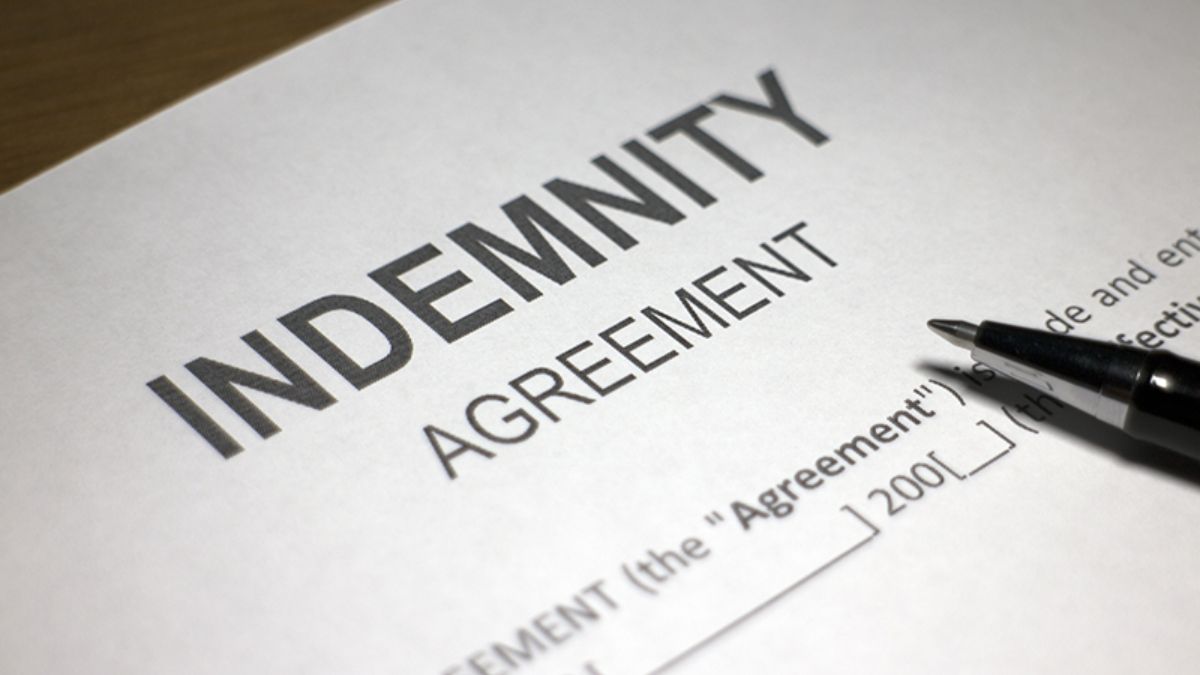An indemnity agreement, often known as a hold harmless agreement, is a contract that transfers risk from one party to another. In essence, one party agrees to compensate for any harm, loss, or damage caused during a specified activity. Here’s a step-by-step guide on how to create an indemnity agreement, along with detailed explanations of important clauses.
Step-by-Step Guide to Creating an Indemnity Agreement
- Identify the Parties Involved: Clearly define the indemnifier (the party providing indemnity) and the indemnitee (the party receiving indemnity).
- Detail the Scope of Indemnity: Specify the actions, events, or situations that the indemnity covers. This includes the nature of the risks and any exclusions.
- Draft the Key Clauses: These clauses include indemnification, defense, hold harmless, limitation of liability, and more. Ensure each clause is clearly defined and detailed.
- Include Recitals: Provide a background or context for the agreement. This section explains why the agreement is being made.
- Define Key Terms: Clearly define any technical or legal terms used in the agreement to avoid ambiguity.
- Specify the Duration: Outline the period during which the indemnity is applicable.
- State Governing Law: Indicate which jurisdiction’s laws will govern the agreement.
- Add Signature Blocks: Provide spaces for all parties to sign and date the agreement.

Indemnity Agreement Made Easy with Legitt AI
Create an indemnity agreement fast with Legitt AI—quick, simple, and accurate!
Get Started FreeImportant Clauses Explained
- Indemnification Clause: This clause details the extent of the indemnity provided. It specifies that the indemnifier will compensate the indemnitee for any loss, damage, or liability incurred due to specified actions or events. It should also outline the process for making a claim under the indemnity.
- Hold Harmless Clause: The hold harmless clause stipulates that the indemnifier will not hold the indemnitee liable for any damages or injuries that occur. This clause essentially protects the indemnitee from any lawsuits or claims arising from the specified activities.
- Defense Clause: This clause obligates the indemnifier to defend the indemnitee against any claims or lawsuits related to the indemnified activities. It includes covering legal fees and expenses. The clause should specify whether the indemnifier has the right to control the defense or whether the indemnitee can choose their own legal representation.
- Limitation of Liability Clause: This clause limits the amount of liability that the indemnifier can incur under the agreement. It may specify a maximum monetary limit or exclude certain types of damages (e.g., consequential, indirect, or punitive damages).
- Exclusions Clause: The exclusions clause lists specific events, actions, or circumstances that are not covered by the indemnity. This helps to narrow the scope of indemnity and manage risks effectively. Common exclusions include acts of gross negligence or willful misconduct by the indemnitee.
- Duration Clause: This clause defines the time period during which the indemnity is valid. It may specify a start and end date or state that the indemnity applies as long as the contractual relationship between the parties exists.
- Notice of Claim Clause: The notice of claim clause outlines the procedure for notifying the indemnifier of a claim. It specifies the timeframe within which the indemnitee must inform the indemnifier about a potential claim and the details that must be included in the notice.
- Subrogation Clause: This clause grants the indemnifier the right to step into the shoes of the indemnitee and pursue recovery from third parties who may be responsible for the loss. Subrogation allows the indemnifier to mitigate their losses by seeking compensation from others.
- Waiver of Subrogation Clause: In contrast to the subrogation clause, this clause prevents the indemnifier from seeking recovery from third parties. It is often included to maintain good business relationships and avoid further litigation.
- Confidentiality Clause: The confidentiality clause requires both parties to keep certain information confidential. This is crucial when sensitive information is exchanged as part of the indemnity agreement. It should outline what constitutes confidential information and the obligations of the parties to protect it.
- Severability Clause: This clause ensures that if any part of the agreement is found to be unenforceable, the remaining provisions will still be in effect. It helps to preserve the validity of the agreement even if one clause is invalidated.
- Entire Agreement Clause: The entire agreement clause states that the indemnity agreement constitutes the full understanding between the parties and supersedes any prior agreements or understandings. This prevents any confusion or disputes over previous verbal or written agreements.
- Amendment Clause: This clause outlines the process for making changes to the agreement. It typically requires that any amendments be in writing and signed by both parties. This ensures that both parties are aware of and agree to any modifications.
- Governing Law Clause: The governing law clause specifies which jurisdiction’s laws will apply to the interpretation and enforcement of the agreement. It is important to choose a jurisdiction that is favorable to both parties and has a well-established legal framework.
- Signature Blocks: The signature blocks provide spaces for the authorized representatives of both parties to sign and date the agreement. This formalizes the agreement and indicates that both parties have read, understood, and agreed to the terms.
Read More: How to Write a Contract
Creating an Indemnity Agreement Using Legitt AI
Creating an Indemnity Agreementcan be complex, but leveraging technology like Legitt AI can simplify the process. Legitt AI’s Contract Generator allows you to quickly and efficiently draft customized agreements tailored to your specific needs. Additionally, you can e-sign your document using Legitt Sign , ensuring that the agreement is legally binding and secure. For those looking for a starting point, Legitt AI offers Free Contract Templates that can be customized to meet your requirements.
FAQs on Indemnity Agreement
What is an indemnity agreement?
An indemnity agreement is a contract where one party agrees to compensate another for any loss, damage, or liability incurred. It transfers risk from one party to another and is commonly used in business transactions and contractual relationships.
Who are the parties involved in an indemnity agreement?
The parties involved are the indemnifier, who provides the indemnity, and the indemnitee, who receives the indemnity. The indemnifier agrees to cover any losses or damages the indemnitee may incur.
What is the purpose of an indemnity agreement?
The purpose is to protect one party from financial loss due to the actions or negligence of another party. It helps manage risk and provides a clear framework for compensation.
What is a hold harmless clause?
A hold harmless clause protects the indemnitee from being held liable for damages or injuries. It ensures that the indemnifier takes full responsibility for any claims arising from the specified activities.
What is the difference between an indemnification clause and a hold harmless clause?
An indemnification clause focuses on compensating for losses, while a hold harmless clause focuses on protecting against liability. Both clauses transfer risk but have different scopes.
How is a limitation of liability clause used in an indemnity agreement?
It limits the amount of liability the indemnifier can incur. It may set a maximum monetary limit or exclude certain types of damages to manage the indemnifier's risk.
What should be included in a notice of claim clause?
It should specify the timeframe for notifying the indemnifier of a claim and the required details. This ensures timely communication and proper handling of claims.
What is the purpose of a subrogation clause?
It allows the indemnifier to seek recovery from third parties responsible for the loss. It helps mitigate the indemnifier's losses by pursuing compensation from others.
Why include a waiver of subrogation clause?
It prevents the indemnifier from seeking recovery from third parties. It is used to maintain good business relationships and avoid further litigation.
What is a confidentiality clause?
It requires parties to keep certain information confidential. It protects sensitive information exchanged during the indemnity agreement and outlines the obligations to safeguard it.
What is the significance of a severability clause?
It ensures that if any part of the agreement is unenforceable, the rest remains effective. It preserves the agreement's validity even if one clause is invalidated.
Why is an entire agreement clause important?
It states that the indemnity agreement is the full understanding between the parties, superseding prior agreements. This prevents confusion or disputes over previous agreements.
How can an indemnity agreement be amended?
Amendments must be in writing and signed by both parties. This ensures that both parties agree to and are aware of any modifications to the agreement.
What does the governing law clause specify?
It specifies which jurisdiction's laws apply to the agreement. It ensures clarity on legal interpretations and enforcement.
Why are signature blocks important in an indemnity agreement?
They formalize the agreement by providing spaces for authorized representatives to sign and date it. This indicates that both parties have agreed to the terms.
